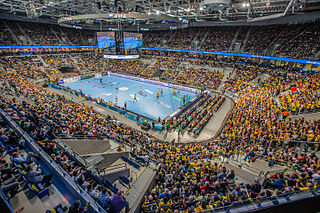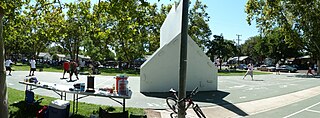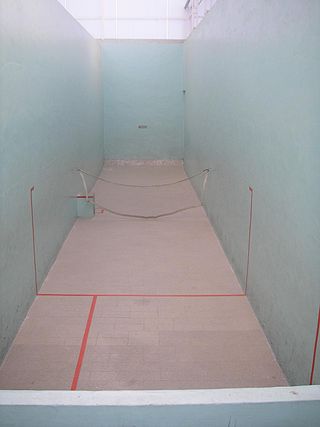
Handball is a team sport in which two teams of seven players each pass a ball using their hands with the aim of throwing it into the goal of the opposing team. A standard match consists of two periods of 30 minutes, and the team that scores more goals wins.

Jai alai is a sport involving bouncing a ball off a walled-in space by accelerating it to high speeds with a hand-held wicker, commonly referred to as a cesta. It is a variation of Basque pelota. The term jai alai, coined by Serafin Baroja in 1875, is also often loosely applied to the fronton where matches take place. The game, whose name means "merry festival" in Basque, is called cesta-punta in the Basque Country. The sport is played worldwide, but especially in Spain, France, the U.S. state of Florida, and in various Latin American countries.

The Gaelic Athletic Association is an Irish international amateur sporting and cultural organisation, focused primarily on promoting indigenous Gaelic games and pastimes, which include the traditional Irish sports of hurling, camogie, Gaelic football, Gaelic handball and rounders. The association also promotes Irish music and dance, as well as the Irish language and it also promotes environmental stewardship through its Green Clubs initiative.

American handball, known as handball in the United States and sometimes referred to as wallball, is a sport in which players use their hands to hit a small, rubber ball against a wall such that their opponent(s) cannot do the same without the ball touching the ground twice or hitting out-of-bounds. The three versions are four-wall, three-wall and one-wall. Each version can be played either by two players (singles), three players (cutthroat) or four players (doubles), but in official tournaments, singles and doubles are the only versions played.

Gaelic games are a set of sports played worldwide, though they are particularly popular in Ireland, where they originated. They include Gaelic football, hurling, Gaelic handball and rounders. Football and hurling, the most popular of the sports, are both organised by the Gaelic Athletic Association (GAA). Women's versions of hurling and football are also played: camogie, organised by the Camogie Association of Ireland, and ladies' Gaelic football, organised by the Ladies' Gaelic Football Association. While women's versions are not organised by the GAA, they are closely associated with it but are still separate organisations.

Basque pelota is the name for a variety of court sports played with a ball using one's hand, a racket, a wooden bat or a basket, against a wall or, more traditionally, with two teams face to face separated by a line on the ground or a net. The roots of this class of games can be traced to the Greek and other ancient cultures.

Gaelic handball is a sport where players hit a ball with a hand or fist against a wall in such a way as to make a shot the opposition cannot return, and that may be played with two (singles) or four players (doubles). The sport, popular in Ireland, is similar to American handball, Welsh handball, fives, Basque pelota, Valencian frontó, and more remotely to racquetball or squash. It is one of the four Gaelic games organised by the Gaelic Athletic Association (GAA). GAA Handball, a subsidiary organisation of the GAA, governs and promotes the sport.

Stadium de Toulouse, previously named Stadium Municipal, is the largest multi-purpose stadium in Toulouse, France. It is currently used mostly for football matches, mainly those of the Toulouse Football Club, as well as rugby matches for Stade Toulousain in the European Rugby Champions Cup or Top 14. It is located on the island of Ramier near the centre of Toulouse. It is a pure football and rugby ground, and therefore has no athletics track surrounding the field. The stadium is able to hold 33,150 people.

Paleta frontón is a Peruvian sport that was born in the capital, Lima, in 1945. This sport has its roots in the "pelota vasca" brought by the Spanish settlers, and the domestic "pelota mano", called "handball" at that time due to English influence. The sport is similar to squash but is played on an open court.

Valencian pilota is a traditional handball sport played in the Valencian Community. Its origins are not known.
Frontó is a modified Valencian pilota version of the original Basque Pelota game. The name frontó refers both to the game, ball and the playing area. Unlike some of the more popular Valencian Pilota rules, frontó is an indirect game, that is, players do not stand face-to-face but share a common playing area.
The following is an alphabetical list of terms and jargon used in relation to Gaelic games. See also list of Irish county nicknames, and these are very interesting.
The International Ball game Confederation, founded on May 13, 1928, is the organization that manages the common activities of the many ball games deriving from Jeu de paume.

Galotxetes is a modality of the Valencian pilota. As usual in the Valencian pilota, it's a handball game where players stand in front of each other. The differences with the main variant are the unusual court and the unique ball used. Despite the name, it has no relation with another Valencian pilota variant, the Galotxa.
The 2007 edition of the Handball International Championships was the VII European Championship, organized by the International Ball game Confederation, and was held at the Belgian cities of Nivelles and Buizingen during September 21 and 23.
GAA Handball Ireland is the governing body for the sport of Gaelic handball in all of its codes in Ireland. Handball is one of the four Gaelic games organised by the Gaelic Athletic Association.
UK Wallball is the governing body for the sport of Wallball in the United Kingdom.
The European 1-Wall Tour, also known as the European Wallball Tour or the 'Euro 1 Wall' Tour, is a One-Wall handball/Wallball tour that takes place at various stops across Europe including the Netherlands, Belgium, the United Kingdom, Spain and Italy.
Wallball is a name given to several sports that involve hitting a ball off of a wall with one's hands or feet. It may refer to:
The Irish Wallball Nationals is a wallball/one-wall handball tournament held annually in Ireland in early July. The tournament is the main wallball/One-wall handball on the Irish handball calendar.












